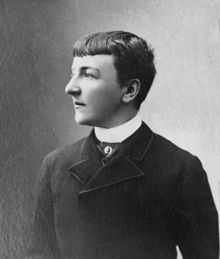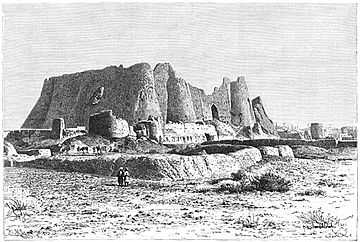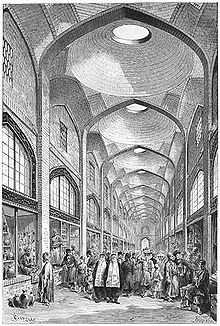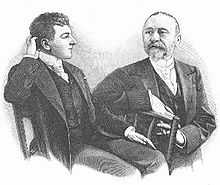Jane Dieulafoy
 Jane Dieulafoy, ca. 1895 | |
| Other names |
Madame Dieulafoy, Jeanne Dieulafoy, Jeanne Henriette Magre |
|---|---|
| Born |
June 29, 1851 Toulouse, France |
| Died |
May 25, 1916 (aged 64) Haute-Garonne, France |
Main interests | Middle East, Persia |
Major works | First French excavations at Susa |
Jane Dieulafoy (29 June 1851 – 25 May 1916) was a French archaeologist, explorer, novelist and journalist. She was the wife of Marcel-Auguste Dieulafoy. Together with her husband, she is known for her excavations at Susa.
Career
Jane Dieulafoy was born Jeanne Henriette Magre to a wealthy family in Toulouse, France. She studied at the Couvent de l’Assomption d’Auteuil in Paris from 1862 to 1870. She married Marcel Dieulafoy in May 1870, at the age of 19. That same year, the Franco-Prussian War began. Marcel volunteered, and was sent to the front. Jane accompanied him, wearing a soldier's uniform[1] and fighting by his side.[2]
With the end of the war, Marcel was employed by the Midi railways, but during the next ten years the Dieulafoys would travel in Egypt and Morocco for archaeological and exploration work. Jane did not keep a record of these journeys. Marcel became increasingly interested in the relationship between Oriental and Western architecture, and in 1879 decided to devote himself to archaeology.[3]


The Dieulafoys first visited Persia in 1881, and would return twice after that. The first journey to Persia was by freighter from Marseilles to Constantinople, by a Russian boat to Poti on the east coast of the Black Sea, and then across the Caucasus and via Azerbaijan to Tabriz.[4] From there they travelled widely through Persia, to Tehran, Esfahan and Shiraz.[3] Jane Dieulafoy documented the pair's explorations in photographs, illustrations, and writing. She took daily notes during her travels, which were later published in two volumes.[5]
At Susa, the couple found numerous artifacts and friezes, several of which were shipped back to France. One such find is the famous Lion Frieze on display at the Louvre.[6] Two rooms in the museum were named after her. For her contributions, the French government conferred upon her the title of Chevalier of the Legion of Honor in 1886.[5]
After their journeys in Iran, Dieulafoy and her husband also spent time traveling in Spain and Morocco between 1888 and 1914. She also wrote two novels: Her first was Parysatis, in 1890, set in ancient Susa. It was later adapted into an opera by Camille Saint-Saëns. Her second, Déchéance, was published in 1897.[5] Marcel was sent to Rabat, Morocco during the First World War, and Jane followed him. While in Morocco, her health began to decline. She contracted amoebic dysentery[7] and she was forced to return to France where she died in Pompertuzat in 1916.
Feminist attitudes

During her travels abroad, Jane Dieulafoy preferred to dress in men's clothing and wear her hair short, because it was impossible and dangerous for a woman to travel freely in a Moslem country. She explained it in her first travel story about Persia. But she kept dressing in men's clothing when she came back in France. This was against the law in France at the time, but when she returned from the Middle East she received special "permission de travestissement" from the government.[2] Dieulafoy chose to wear men's clothing for practical reasons. She wrote, "I only do this to save time. I buy ready-made suits and I can use the time saved this way to do more work."[8]
Dieulafoy considered herself an equal to her husband, but was also fiercely loyal to him. She was opposed to the idea of divorce, believing it degraded women.[9] She spoke out about women's rights. During the First World War, she petitioned for allowing women a greater role in the military.[5]
Bibliography
Major published works:[5]
- La Perse, la Chaldée et la Susiane 1881–1882. Paris. 1887.
- L’Orient sous le voile. De Chiraz à Bagdad 1881–1882 (vol 2). Paris. 1889.
- À Suse 1884–1886. Journal des fouilles. Paris. 1888.
- Rose d’Hatra et L’Oracle (short stories). Paris. 1893.
- Aragon et Valence. Paris. 1901.
- L’épouse parfaite (translation from Fray Luis de León). Paris. 1906.
- Castille et Andalousie. Paris. 1908.
- Isabelle la Grande. Paris. 1920.
Biographies
- Adams, Amanda, Ladies of the Field: Early Women Archaeologists and Their Search for Adventure, Douglas & McIntyre, ISBN 978-1-55365-433-9
References
- ↑ Adams 2010, pp. 49.
- ↑ 2.0 2.1 MME. JANE DIEULAFOY DEAD....
- ↑ 3.0 3.1 Cohen & Joukowsky 2006, pp. 39.
- ↑ Cohen & Joukowsky 2006, pp. 41.
- ↑ 5.0 5.1 5.2 5.3 5.4 Calmard 1995.
- ↑ Adams 2010, pp. 42.
- ↑ Adams 2010, pp. 61.
- ↑ Adams 2010, pp. 56.
- ↑ Adams 2010, pp. 57.
Sources
- Adams, Amanda (2010). "Jane Dieulafoy — All Dressed Up In a Man's Suit". Ladies of the Field: Early Women Archaeologists and Their Search for Adventure. Greystone Books. ISBN 1-55365-433-1.
- Calmard, Jean (15 December 1995). "Dieulafoy, Jeanne Henriette Magre". Encyclopedia Iranica. Retrieved 2011-09-07.
- Cohen, Getzel M.; Joukowsky, Martha Sharp (2006). "Jane Dieulafoy (1851-1916)". Breaking Ground: Pioneering Women Archaeologists. University of Michigan Press. ISBN 0-472-03174-0.
- "MME. JANE DIEULAFOY DEAD.; Explorer and Author Fought Through Franco-Prussian War". The New York Times. May 28, 1916. Retrieved 2011-09-07.
External links
| Wikimedia Commons has media related to Jane Dieulafoy. |
|